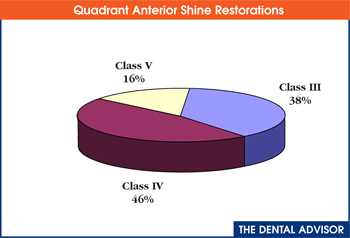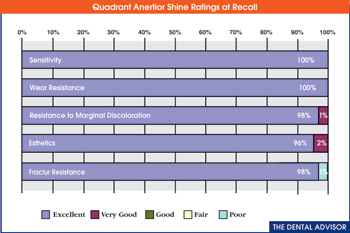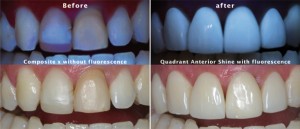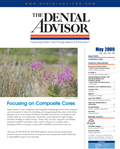Clinical Evaluations
Quadrant Anterior Shine (1 yr)
Consultants’ Comments
- “Quadrant Anterior Shine finishes to a smooth surface.”
- “Shades blend nicely with the surrounding enamel.”
- “Creamy composite handles well and is easy to sculpt.”
Description
Quadrant Anterior Shine is a light-cured, radiopaque, micro-hybrid composite that is filled 63% by volume and 74% by weight. The composite is indicated for Class III, IV, and V restorations and is available in 15 shades: A1, A2, A3, A3.5, A4, B2, B3, C2, C4, D3, OA2, OA3.5, Dark, Incisal, and Bleach. Quadrant Anterior Shine is available in 0.25-g unit-dose capsules and 4-g syringes. This product received a 97% clinical rating.
Clinical Evaluation Protocol
- 268 Quadrant Anterior Shine restorations were placed in 123 patients.
- Class III, Class IV and Class V anterior restorations were placed (Figure 1).
- 50 restorations were available for evaluation of clinical performance up to 12 months after placement.
- Restorations were evaluated on a 1-5 rating scale: 1 = poor, 2 = fair, 3 = good, 4 = very good, 5 = excellent.

Figure 1
Clinical Observations
Fracture Resistance
The majority of Quadrant Anterior Shine restorations remained intact during the first year after placement (Figure 2). One Class III restoration fractured at five months and was replaced.
Esthetics
Quadrant Anterior Shine was used mainly in areas where esthetics was a primary concern. In most cases the composite exhibited excellent blending with the surrounding enamel. The specialty shades enhance the range of Vita shades for accurate shade matching in the majority of cases. All restorations were rated very good to excellent at recall (Figure 2).
Resistance to Marginal Discoloration
Various 5th- and 6th-generation bonding agents were used to bond the Quadrant Anterior Shine restorations. With only one exception, all restorations were resistant to staining at the cavosurface margins (Figure 2).
Wear ResistanceNo visible signs of wear were noted on any of the restorations recalled (Figure 2).
Sensitivity
No post-operative sensitivity was reported when patients were queried at their recall appointments (Figure 2).

Figure 2
Summary
Quadrant Anterior Shine was used to place 268 restorations in 123 patients. At one-year recall, the majority of Quadrant Anterior Shine restorations remained intact during the first year after placement. No visible signs of wear were noted. Nearly all restorations were resistant to staining at the cavosurface margins. In most cases the composite exhibited excellent blending with the surrounding enamel. No post-operative sensitivity was reported.


